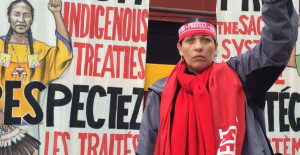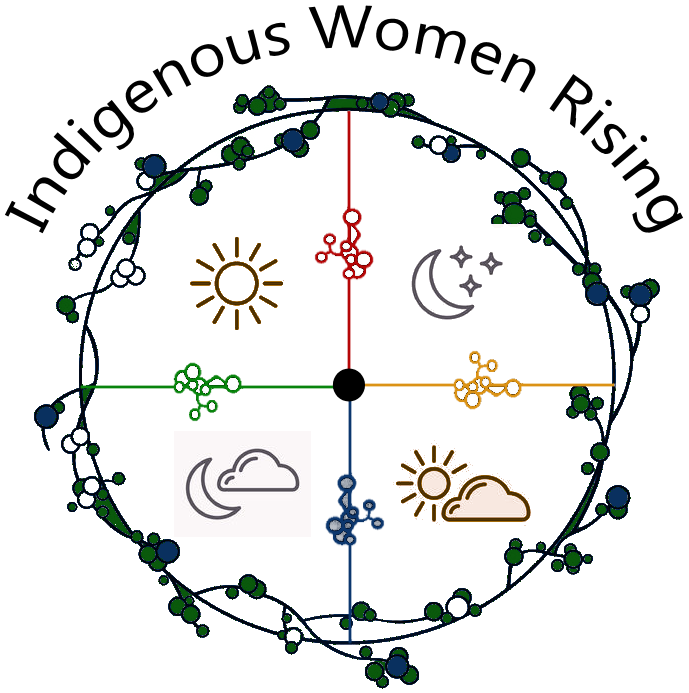By: Cherri Foytlin
 Last week in Paris a historic document was signed. This instrument carries the weight and responsibility of protecting a threatened world. Dignitaries came from oceans away to gather, bear witness and testify to the undeniable truth that our planet is in deep trouble. At the assembly’s conclusion, the participants each took a turn signing their pledge of support in protecting Mother Earth for future generations.
Last week in Paris a historic document was signed. This instrument carries the weight and responsibility of protecting a threatened world. Dignitaries came from oceans away to gather, bear witness and testify to the undeniable truth that our planet is in deep trouble. At the assembly’s conclusion, the participants each took a turn signing their pledge of support in protecting Mother Earth for future generations.
Although the Indigenous Women of the Americas – Defenders of Mother Earth Treaty Compact 2015 may not be the accord that the media and many environmental organizations are celebrating, I’ll put my hope into this vessel over the leaky one that came out of COP21 any day.
While recognizing that the Paris Accord is at least and finally a recognition by world leaders that climate change is real, it is happening, human activity is a primary cause, and immediate steps must be taken to protect the world, weak language around carbon reduction, lack of strong support for indigenous rights and a deprivation of binding and trans-formative systems change, does little to fully address the exigency of climate disruption.
And perhaps it is a signal that the Fossil Fuel Age is coming to an end, but sitting on my porch in South Louisiana, I’m finding that hard to perceive.
Where I reside land loss equates to watching a football field an hour slip off into the Gulf of Mexico. A million football fields are now gone.
As it stands, within the next year, the US government plans to auction off basically the remaining areas of the Gulf of Mexico as leases to the oil and gas industry.
That would be the same body of water where Shell is currently drilling rigs in the greatest water depths ever.
Macondo, where BP’s disastrous “spill” originated, is also back to “drill, baby, drill.”
I live in the region where the Keystone XL battle was lost, and where TransCanada has now joined with the State Department to construct a 155-mile fractured gas pipeline to Mexico.
In my region, environmental justice communities dot the landscape and drilling rigs dot the seascape.
Excuse my withholding of enthusiasm, but from my view, the exploitive age of extreme extraction is far from over.
But I do have hope.
The Indigenous Women’s Treaty was originally signed on September 27, in traditional Lanape Territory, now called New York. Representatives from the North and the South came together in sacred ceremony to, in the words of Ponca elder Casey Camp-Horinek, “honor the ancestors who brought us to this point where we could stand strong in unified love of our Mother the Earth, our Father the Sky and the undying duty to protect the air, water, earth and all of our relatives for the future generations.”
In Paris, on Sunday, December 6, many of the original signers again entered into ceremony. At that time the Treaty was expanded to include additional signatories from some of the most injured territories of Mother Earth. As the ink danced from hands to paper, this powerful gathering of women sang and prayed together, in one voice.
More than a hollow mandate, the Treaty is a love song to the world. It is both a prayer and a decree, for the human acceptance of the sacred teachings and values of the ancestors, and a commitment as defenders to the cause of survival and the advancement of generations to come.
That is where the Indigenous Women’s Treaty differs from the Paris accord. This living document is communed by all that has ever been and all that will ever be. It is an invitation, an appeal to all women of the world, to join together as life givers and protectors, and to take our obligated and sacred commission in stopping the destruction of the only known origin of life.
“We are drawing the line and saying that the harms stop here and now. No more fossil fuel infrastructure or extraction, no more genetically modified organisms, no more toxins in our water, soil and air, and no more commodifying and privatizing of the earth, air, water, soil and natural systems,” as the Treaty reads.
Our Mother will not be saved by suits making wishes, it will come from the hard work and the fierce passion and compassion of those who have taken a solemn oath of action to protect, defend, and renew the sacred systems of life. It will come from the streets, from the jungles, from the mountains, from the deserts and oceans, from those who will refuse the violence of colonizing extreme extraction in every form, in every part of the world.
And it is women who have suffered the most under oppressive systems that promote and profit from the death of the living world, and it is women who will heal her.
In closing, I would like to share with you an historic even being held on March 23 in New Orleans, Louisiana. The people of my region are preparing to make a statement by surrounding the Superdome on the day of the drilling lease auction. We will stand in opposition of the violence toward Mother Earth. We invite you to join us. We are drawing the line, the harm stops here.
